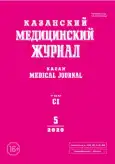Влияние расстояния от пилорического сфинктера и размера калибровочного зонда на результаты продольной резекции желудка
- Авторы: Омаров Т.И.1,2, Байрамов Н.Ю.1, Гусейнова М.Р.2, Зейналов Н.А.1
-
Учреждения:
- Азербайджанский медицинский университет
- Moдeрн гoспитал
- Выпуск: Том 101, № 5 (2020)
- Страницы: 669-676
- Тип: Теоретическая и клиническая медицина
- URL: https://journal-vniispk.ru/kazanmedj/article/view/19135
- DOI: https://doi.org/10.17816/KMJ2020-669
- ID: 19135
Цитировать
Аннотация
Цель. Изучение влияния диаметра калибровочного зонда и расстояния от пилорического сфинктера на результаты лапароскопической продольной резекции желудка.
Методы. В исследование были включены 945 пациентов (915 женщин) с индексом массы тела 51,5±9 кг/м2. Средний возраст пациентов составлял 53,5±8,5 года. Пациенты были разделены на две группы в зависимости от типа лапароскопической операции. В первой группе (n=463) использовали калибровочной зонд 36 Fr, расстояние от пилорического сфинктера составляло 4–6 см; во второй группе (n=482) применяли калибровочной зонд 32 Fr, расстояние от пилорического сфинктера составляло 2–3 см. Основным критерием сравнения служил процентный показатель потери массы тела в первые 6 и 12 мес, а дополнительным критерием сравнения — послеоперационное течение сопутствующих заболеваний и наличие осложнений.
Результаты. Сравнительный анализ показал, что первая группа в первые 6 мес потеряла 59±3% своей первоначальной массы тела, через 12 мес — 71±4%; во второй группе — соответственно 73±3 и 87±3% исходной массы тела (р <0,05). Сопутствующие заболевания в первой группе уменьшились на 70–80% к 6-му месяцу после операции и на 85–96% к 12-му месяцу. Во второй группе аналогичная ремиссия с улучшением на 6-м месяце составила 84–94%, а на 12-м месяце показатели остались на прежнем уровне (р <0,05).
Вывод. Результаты исследования показывают, что при использовании калибровочного зонда 32 Fr и при расстоянии 2–3 см от пилорического сфинктера во время лапароскопической продольной резекции желудка по сравнению с применением калибровочного зонда 36 Fr и более при расстоянии 4–6 см от пилорического сфинктера происходит более быстрая и эффективная потеря массы тела с более ранним исчезновением сопутствующих заболеваний, количество осложнений сопоставимо.
Ключевые слова
Полный текст
Открыть статью на сайте журналаОб авторах
Тариел Искендер оглу Омаров
Азербайджанский медицинский университет; Moдeрн гoспитал
Автор, ответственный за переписку.
Email: taryelomerov@gmail.com
Азербайджан, г. Баку, Азербайджан; г. Баку, Азербайджан
Нуру Юсиф оглу Байрамов
Азербайджанский медицинский университет
Email: taryelomerov@gmail.com
Азербайджан, г. Баку, Азербайджан
Мехрибан Рафаэль кызы Гусейнова
Moдeрн гoспитал
Email: taryelomerov@gmail.com
Азербайджан, г. Баку, Азербайджан
Надир Азер оглу Зейналов
Азербайджанский медицинский университет
Email: taryelomerov@gmail.com
Азербайджан, г. Баку, Азербайджан
Список литературы
- Berger E.R., Clements R.H., Morton J.M. et al. The impact of different surgical techniques on outcomes in laparoscopic sleeve gastrectomies: the first report from the Metabolic and Bariatric Surgery Accreditation and Quality Improvement Program (MBSAQIP). Ann. Surg. 2016; 264: 464–473. doi: 10.1097/SLA.0000000000001851.
- El Geidie A., El Hemaly M., Hamdy E. et al. The effect of residual gastric antrum size on the outcome of laparoscopic sleeve gastrectomy: a prospective randomized trial. Surg. Obes. Relat. Dis. 2015; 11: 997–1003. doi: 10.1016/j.soard.2014.12.025.
- English W.J., De Maria E.J., Brethauer S.A. et al. American Society for Metabolic and Bariatric Surgery estimation of metabolic and bariatric procedures performed in the United States in 2016. Surg. Obes. Relat. Dis. 2018; 14: 259–263. doi: 10.1016/j.soard.2017.12.013.
- Gagner M., Deitel M., Erickson A.L., Crosby R.D. Survey on laparoscopic sleeve gastrectomy (LSG) at the Fourth International Consensus Summit on Sleeve Gastrectomy. Influence of antrum size on gastric emptying and weight-loss outcomes after laparoscopic sleeve gastrectomy (preliminary analysis of a randomized trial). Surg. Endosc. 2018; 32: 2739–2745. doi: 10.1007/s00464-017-5972-4.
- Garay M., Balague C., Rodriguez-Otero C. et al. Influence of antrum size on gastric emptying and weight-loss outcomes after laparoscopic sleeve gastrectomy (preliminary analysis of a randomized trial). Surg. Endosc. 2018; 32: 2739–2745. doi: 10.1007/s00464-017-5972-4.
- Ilhan Ece, Huseyin Yilmaz, Husnu Alptekin et al. Comparative effectiveness of laparoscopic sleeve gastrectomy on morbidly obese, super-obese, and super-super obese patients for the treatment of morbid obesity. Obes. Surg. 2018; 28: 1484–1491. doi: 10.1007/s11695-017-3053-3.
- Omer Avlanmis, Riza Gurhan Isil, Busra Burcu. Effect of resection distance from pylorus on weight loss outcomes in laparoscopic sleeve gastrectomy. Obes. Surg. doi: 10.1007/s11695-019-03923-3.
- Cal P., Deluca L., Jakob T., Fernández E. Laparoscopic sleeve gastrectomy with 27 versus 39 Fr bougie calibration: a randomized controlled trial. Surg. Endosc. 2016; 30: 1812–1815. doi: 10.1007/s00464-015-4450-0.
- Spivak H., Rubin M., Sadot E. et al. Laparoscopic sleeve gastrectomy using 42-French versus 32-French bougie: the first-year outcome. Obes. Surg. 2014; 14 (7): 1090–1093. doi: 10.1007/s11695-014-1199-9.
- Weiner R.A., Weiner S., Pomhoff I. et al. Laparoscopic sleeve gastrectomy—influence of sleeve size and resected gastric volume. Obes. Surg. 2007; 17 (10): 1297–1305. doi: 10.1007/s11695-007-9232-x.
- Yormaz S., Yilmaz H., Ece I. et al. Midterm clinical outcomes of antrum resection margin at laparoscopic sleeve gastrectomy for morbid obesity. Obes. Surg. 2017; 27: 910–916. doi: 10.1007/s11695-016-2384-9.
Дополнительные файлы







